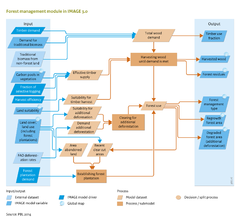Forest management: Difference between revisions
Jump to navigation
Jump to search
No edit summary |
No edit summary |
||
| Line 7: | Line 7: | ||
|Description==== Global context === | |Description==== Global context === | ||
The world’s total forest area | The world’s total forest area and other wooded land area of 2010 was estimated at just over 40 and 11 million km2 , respectively (FAO, 2010). People use these forests as resources for a multitude of purposes, such as for timber, fuel, food, water and other forest-related goods and services. Notwithstanding the undisputed market and non-market value of forests, the total global forest area continues to decline, with distinct differences between world regions. Total global deforestation has decreased over the last decade, but still occurs at a significant scale in large parts of Latin America, Africa and Southeast Asia. At the same time, net forest expansion takes place in other regions, such as in Europe and China. Agricultural expansion is the main pressure that drives deforestation. In addition to the loss of forest area, degradation processes and a decline in the supply of services may occur as a result of the human use of forests. Managing global forest resources in a sustainable way may help to preserve forests, slow down or reverse the degradation process, while conserving their biodiversity and carbon stocks (FAO, 2010). | ||
Several types of forest management systems | Several types of forest management systems are in use to meet worldwide demand, for timber, paper, fibre board, biofuel and other products. Management practices depend on forest type, conservation policies and regulation, economics, and other –often local– factors. Practices differ with respect to the volume of wood harvested per area, the rotation cycle and the carbon content and state of biodiversity of the forested areas. Harvested wood is used for various purposes, such as for timber, pulp, paper, traditional fuel wood and modern forms of bio-energy. | ||
=== Forestry in the IMAGE 3.0 model === | === Forestry in the IMAGE 3.0 model === | ||
Because of the importance of forest management for the functioning and state of forests, its modelling has become an | Because of the importance of forest management for the functioning and state of forests, its modelling has become an integral part of the IMAGE 3.0 model. The model simulates an forest area in 2010 of total about 46 million km2. As such the area is somewhat larger than observed, due to the fact that the model does not include other wooded land (see Carbon Cycle and Natural Vegetation module for details). To manage these forests three types of systems are defined in IMAGE 3.0 as a simplification of the whole range of existing forest management systems (Carle and Holmgren, 2008; Arets et al., 2011). The purpose of Sustainable Forest Management (SFM) is to preserve forests and their production capacity and biodiversity for future generations, and to counteract forest degradation processes. In IMAGE, several elements of SFM can be included, subject to policy options, consisting for example of shifts in the mix of forest management systems. | ||
The first management | The first type of forest management included in IMAGE, is that of clearcutting (or clearfelling). This is a management system by which all trees in an area are cut down, after which regrowth can take place, either naturally or ‘assisted’. It is applied often in temperate regions, where stands are often monocultures of specific endemic species. | ||
The second type is that of selective logging, in which only the trees with the highest economic value are felled. This is more common in tropical forests with a high heterogeneity of tree species. Reduced impact logging (RIL) is an ecological variant of selective logging, to reduce harvest damage, stimulate regrowth and maintain biodiversity levels (Putz et al., 2012). As such, the RIL system is a more ecological and sustainable forest management system, which is promoted under SFM schemes. | |||
The third system is that of forest plantations, such as hardwoodtree plantations in the tropics and poplar plantations in temperate regions. Selected tree species, either endemic or exotic to the area, are planted and managed more intensively – for example, through irrigation and fertilizer use – to maximise production and/or wood quality. After the trees are harvested, new ones are planted, and management is put in place. Forest plantations generally have a high productivity level (Del Lungo et al., 2006). By producing more wood and wood products on less land, plantations may contribute to more sustainable forest management by reducing the pressures on natural forests (Carle and Homgren, 2008; Alkemade et al., 2009). At the same time, the ecological value of biodiversity in many forest plantations is relatively low (Hartman et al., 2010). | |||
|ComponentCode=FM | |ComponentCode=FM | ||
|AggregatedComponent=Agriculture and land use | |AggregatedComponent=Agriculture and land use | ||
|FrameworkElementType=pressure component | |FrameworkElementType=pressure component | ||
}} | }} | ||
Revision as of 15:48, 25 March 2014
Parts of Forest management
| Component is implemented in: |
| Components: |
| Related IMAGE components |
| Projects/Applications |
| Key publications |
| References |
Key policy issues
- How can management influence forest capacity to meet future demand for wood and other ecosystem services?
- What are the implications of forest management for pristine and managed forest areas, and on biomass and carbon stocks and fluxes of relevance for climate policy?
- What are the prospects for more sustainable forest management and the role of production in dedicated forest plantations?
